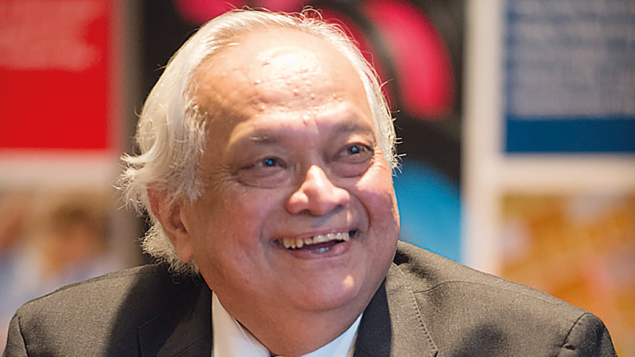
Bikash Sinha, a pioneer in the field of quark–gluon plasma and the early universe, passed away on 11 August 2023 at the age of 78. His influence on heavy-ion physics is woven into the fabric of not only the ALICE experiment but also the broader field.
Bikash Sinha was born on 16 June 1945 in Kandi, Murshidabad in the state of West Bengal, India. After graduating in physics from Presidency College, Kolkata in 1964, he went to the UK where he completed the natural sciences Tripos course at King’s College, Cambridge in 1967, and then gained a PhD in nuclear physics from the University of London in 1970. He returned to India on invitation from nuclear physicist Raja Ramanna and joined the Bhabha Atomic Research Centre (BARC) in 1976.
In the early 1980s Bikash started working in high-energy physics, particularly relativistic heavy-ion collisions and the formation of quark–gluon plasma. He was appointed director of the Variable Energy Cyclotron Centre in 1987 and held concurrent charge as director of Saha Institute of Nuclear Physics from 1992 to 2009. He received numerous awards and honours, including the Padma Shri Award in 2001 and the Padma Bhusan Award (the third-highest civilian award in the Republic of India) in 2010 for his significant contributions to science and technology. He had also been a member of the scientific advisory council to the Indian prime minister.
As the director of two major institutes in Kolkata, Bikash promoted research in different fields of science. In nuclear and particle physics, his efforts put India on the global map, and he was a strong supporter of the engagement of India with the international community via programmes at CERN. Early on, he broke through scientific bureaucracy to press the need for a multi-agency funding model for the nascent collaborations taking shape for the SPS WA93/WA98 experiments. Subsequently, India’s contributions expanded to the LHC, to RHIC at Brookhaven National Laboratory, and then to FAIR at GSI in Germany.
From modest beginnings in the early 1990s – armed with only a handful of collaborators, students and borrowed equipment, but a grand vision and unbeatable spirit – Bikash nourished and led the Indian team to become a major pillar of ALICE, and of heavy-ion physics more broadly. He embraced every challenge, be it the MANAS chip for the large muon chambers or the photon multiplicity detector, made possible on account of his generous attitude in promoting talents and giving chances to youngsters.
As an individual, Bikash was a synthesis of science, culture, philosophy and society. He initiated the medical cyclotron in Kolkata for the diagnosis and treatment of prostate cancer, and was inspired by the works of the great Indian poet and Nobel Laureate Rabindranath Tagore. In May 2022 he fused his passions for science and art in a one-of-a-kind international conference Microcosmos, Macrocosmos, Accelerator and Philosophy (CERN Courier July/August 2023 p22).
In 1988 Bikash initiated a very successful international conference series on the Physics and Astrophysics of Quark Gluon Plasma, and in 2008 he organised and chaired the annual Quark Matter conference in 2008 held in Jaipur, India. Along the way, his efforts paved the way for India to become one of the most prominent non-member-state participants at CERN, culminating in its accession to associate member in 2017.
While the passing of Bikash leaves an undeniable void, his legacy is a vibrant and thriving team that is primed to continue the journey he embarked upon. We will always remember him for his charismatic personality, great kindness, openness and generosity. We honour his memory, and with deepest condolences we extend our sympathy to his family.








